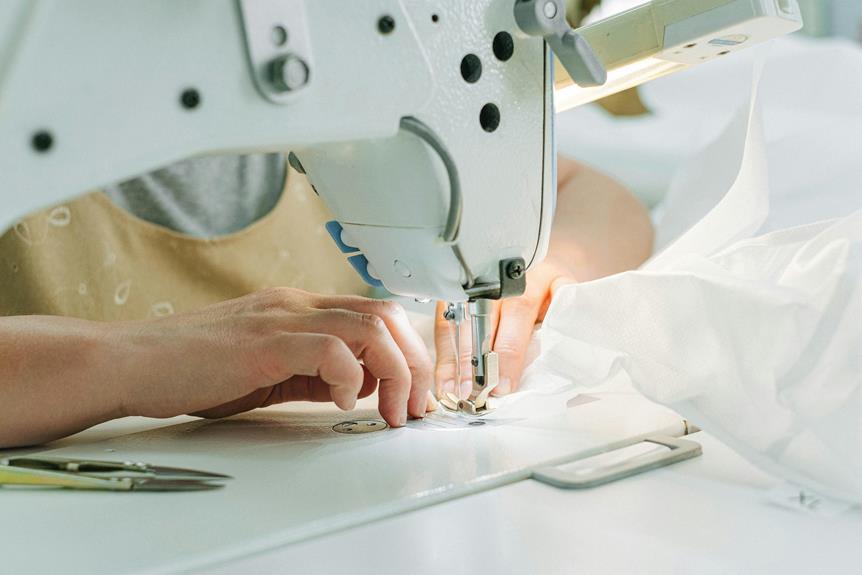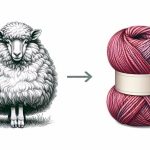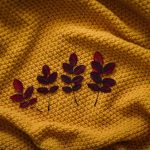When you consider muslin fabric, you might not realize the intricate process behind its creation. It starts with sourcing high-quality cotton, where every step is crucial to ensure the fabric's final quality. After removing seeds and impurities, the cotton fibers are spun into yarn, followed by weaving techniques that define the texture. But that's just the beginning—the dyeing and finishing processes add layers of complexity and character. Curious about how each stage contributes to the muslin you know? Let's explore the details further.
Table of Contents
Key Takeaways
- Muslin fabric is made from high-quality cotton, sourced from sustainable growers and processed to ensure purity and consistency.
- The cotton fibers undergo cleaning, carding, and spinning to create a smooth and durable yarn.
- Weaving techniques, primarily plain weave, are employed to form lightweight muslin fabric with varying textures and strengths.
- Dyeing methods, including piece dyeing and natural dyes, are used to achieve vibrant colors and patterns on the fabric.
Overview of Muslin Fabric
Have you ever wondered what makes muslin fabric so versatile and beloved in the textile world?
Muslin's charm lies in its simplicity and adaptability. This lightweight cotton fabric, often characterized by its plain weave, offers a soft texture that feels great against the skin. You'll find muslin in various weights, ranging from delicate to more substantial forms, giving you plenty of options for different projects.
Muslin's origins date back centuries, initially crafted in the Indian city of Mosul. Today, it's widely used in fashion, quilting, and even culinary applications. Its breathable quality makes it ideal for summer garments, while its ease of dyeing allows for endless creative possibilities. You can use muslin for everything from draping patterns to creating cozy baby blankets.
Additionally, it's a favorite among artists for sketching and painting due to its smooth surface. Because it's affordable and accessible, muslin is perfect for both beginners and seasoned crafters alike.
Whether you're sewing a dress or crafting a backdrop, muslin's flexibility ensures it remains a staple in your fabric collection. Embrace its versatility, and you'll discover countless ways to incorporate muslin into your projects.
Sourcing Raw Cotton
Sourcing raw cotton for muslin involves selecting high-quality fibers that ensure the fabric's softness and durability. You'll want to focus on specific cotton varieties, such as Upland or Pima, known for their fine texture and strength.
When sourcing, consider factors like climate, soil quality, and farming practices, as these directly impact cotton quality. You can start by establishing relationships with reputable cotton growers or suppliers who prioritize sustainable farming methods. This not only supports environmentally friendly practices but often results in better quality cotton.
Look for suppliers who provide certifications, such as organic or Fair Trade, which can indicate superior farming practices and quality assurance. Attend trade shows or industry events to meet potential suppliers and inspect their cotton firsthand.
It's crucial to sample different batches to assess fiber length, strength, and color, as these attributes will affect the final muslin product. By investing time in sourcing, you ensure that you're getting the best raw cotton, setting the stage for high-quality muslin that meets your standards.
Ultimately, the right choices at this stage lead to a better end product, enhancing the overall value of your muslin fabric.
Cotton Fiber Processing
Once you've secured high-quality cotton, the next step is processing the fibers to prepare them for weaving into muslin fabric. This involves several key stages.
First, you'll need to remove the seeds from the cotton bolls. This is done using a cotton gin, which efficiently separates the fibers from the seeds, ensuring you have clean cotton ready for the next phase.
After ginning, the cotton fibers must be cleaned to eliminate any remaining impurities, such as dirt, leaves, and short fibers. A process called carding follows, where the cotton fibers are aligned and separated, forming a fluffy mass known as sliver. This step is crucial as it prepares the fibers for consistent and even spinning.
Next, you'll want to blend different cotton batches if needed, ensuring uniformity in quality and texture. Moisture content is also adjusted at this stage, as it plays a vital role in fiber handling during the subsequent spinning process.
Spinning the Cotton
When spinning cotton, you start with a careful selection of the best fibers to ensure quality.
You'll then explore various spinning techniques that transform those fibers into yarn.
Cotton Selection Process
To create high-quality muslin fabric, selecting the right cotton and spinning it with care is essential. You'll want to begin by choosing the best cotton varieties, such as long-staple cotton, which provides durability and a smooth texture. The right selection ensures your muslin will have the desired softness and strength.
Once you've made your cotton selection, it's crucial to inspect the fibers. Look for uniformity in length and a lack of blemishes or impurities. These factors can significantly impact the final fabric's quality. After ensuring your cotton meets these standards, you can begin preparing it for spinning.
Before spinning, you'll need to clean the cotton, removing any seeds and debris. This step is vital for achieving a smooth finish in the final product. Next, you'll card the fibers, aligning them and breaking up any clumps. This process helps create a consistent fiber thickness, essential for even spinning.
Spinning Techniques Overview
Spinning cotton into muslin involves several techniques that transform the cleaned and carded fibers into strong, fine yarn.
First, you'll encounter the traditional spinning wheel, which allows you to twist the fibers together manually. This method gives you control over the thickness and texture of the yarn, making it a favorite among artisans.
Next, you might work with a spinning frame, a more modern approach. This machine increases efficiency, enabling you to produce larger quantities of yarn while maintaining consistent quality. The spinning frame draws out the fibers and twists them together, ensuring they're tightly bound.
Then, there's ring spinning, known for its ability to create a smooth, high-quality yarn. In this technique, the fibers undergo a continuous twisting process, which results in a finer, stronger product.
Lastly, you may encounter open-end spinning, which utilizes a rotor to create yarn without the need for a spindle. This method is faster and often leads to a bulkier yarn.
Each technique has its unique benefits, and understanding these can help you appreciate the craftsmanship behind muslin fabric.
Quality Control Measures
Ensuring high-quality muslin starts with implementing rigorous quality control measures during the spinning process of cotton. You'll want to begin by carefully selecting the cotton fibers, as their quality directly affects the final product. Inspect the fibers for consistency in length, color, and strength. Any irregularities can lead to weak spots in the fabric, so aim for uniformity.
Next, monitor the spinning machinery. Regular maintenance is crucial to prevent mechanical failures that could compromise the integrity of the cotton. During spinning, keep an eye on the yarn tension. Uneven tension can result in a fabric that's either too loose or too tight, impacting both appearance and durability.
You should also conduct periodic tests on the spun yarn. This includes checking for defects such as slubs, which can detract from the fabric's smoothness. Additionally, evaluate the yarn's strength and elasticity to ensure it meets industry standards.
Weaving Techniques
Weaving techniques play a crucial role in determining the texture and quality of muslin fabric, shaping its final appearance and feel. When you think about muslin, consider the different methods used to weave it, as they greatly influence its characteristics.
The most common weaving technique for muslin is plain weave, where threads are interlaced in a simple over-and-under pattern. This technique creates a lightweight and breathable fabric, making it perfect for various applications.
You might also encounter variations like twill and satin weaves. Twill weaving creates a diagonal pattern, allowing for a sturdier fabric that can provide more durability. Satin weaving, on the other hand, produces a smooth, lustrous surface, which can elevate the fabric's appeal. Each technique offers unique benefits, so understanding them helps you appreciate the versatility of muslin.
Additionally, the choice of yarn thickness and the density of the weave can affect the final product. A tighter weave, for instance, results in a more opaque fabric, while a looser weave enhances breathability.
Dyeing and Finishing
When it comes to dyeing muslin fabric, you'll find various techniques that can bring your desired colors to life.
After dyeing, the finishing process plays a crucial role in enhancing the fabric's texture and durability.
Let's explore these essential steps to understand how they transform muslin into a versatile material.
Dyeing Techniques Overview
Dyeing techniques play a crucial role in enhancing muslin fabric's aesthetic appeal and functionality. When you choose to dye muslin, you're not just adding color; you're transforming the fabric's character. There are several dyeing methods available, each with its unique attributes.
One popular technique is the piece dyeing process, where the entire fabric is dyed after it's woven. This method ensures uniform color, making it ideal for large projects.
If you're looking for a more intricate design, you might consider batik or tie-dye techniques. These methods involve applying dye in specific patterns, creating stunning visuals and textures that stand out.
Another option is the use of natural dyes, which are derived from plants, minerals, or insects. These dyes not only provide beautiful shades but also align with environmentally friendly practices. On the other hand, synthetic dyes offer a wider range of colors and stronger, more consistent results.
Regardless of the method you choose, proper preparation is key. Pre-treating the muslin can help the dye adhere better, ensuring vibrant, lasting colors.
Each technique brings something unique, allowing you to personalize your muslin fabric to suit your needs.
Finishing Process Steps
After exploring various dyeing techniques, it's important to understand the finishing process steps that follow, as they enhance both the appearance and durability of muslin fabric. This stage is crucial for achieving the desired texture, color fastness, and overall quality.
First, the fabric undergoes a washing process to remove any residual chemicals from dyeing. Next, it may be treated with softeners to achieve a more luxurious feel. You'll often find that this treatment also reduces wrinkling, making the fabric easier to care for.
Finally, the muslin is usually pressed or calendared to create a smooth finish. This not only improves its visual appeal but also makes it ready for various applications, whether for crafting, fashion, or home décor.
Here's a quick overview of key finishing steps:
- Washing: Removes excess dye and impurities.
- Softening: Enhances texture and reduces wrinkles.
- Pressing: Smooths out any creases for a polished look.
These finishing touches ensure your muslin fabric looks great and lasts longer, making it a preferred choice for many uses.
Quality Control Measures
To ensure the highest standards, manufacturers implement rigorous quality control measures throughout the muslin fabric production process. These measures help maintain consistency and quality, ensuring that the final product meets customer expectations. From raw material inspection to final product testing, every step is critical.
During the initial stages, manufacturers check the cotton fibers for impurities and defects. They look at the length, color, and overall quality. Once the fibers are spun into yarn, tests are performed to measure strength and elasticity.
As the weaving process begins, operators monitor tension and alignment to avoid faults in the fabric. After weaving, the fabric undergoes additional inspections for weave integrity and color consistency. Finally, the finished muslin is tested for softness and durability before packaging.
Here's a summary of key quality control measures:
| Quality Control Measure | Purpose |
|---|---|
| Raw Material Inspection | Ensures quality fibers |
| Weaving Monitoring | Maintains fabric integrity |
| Final Product Testing | Confirms softness and durability |
Frequently Asked Questions
What Are Common Uses for Muslin Fabric Beyond Clothing?
You'll find muslin fabric used in various ways beyond clothing. It's perfect for making curtains, tablecloths, and craft projects. You can also use it for photography backdrops or as a lightweight cover for food.
Is Muslin Fabric Environmentally Friendly?
Muslin fabric can be environmentally friendly, especially when made from organic cotton. It's biodegradable and often uses less water in production compared to other fabrics, making it a sustainable choice for various applications.
How Does Muslin Compare to Other Fabrics?
When you compare muslin to other fabrics, you'll find it's lightweight, breathable, and versatile. Unlike heavier materials, muslin's softness and absorbency make it ideal for various uses, from clothing to home decor.
Can Muslin Fabric Be Recycled?
Yes, you can recycle muslin fabric! Many recycling programs accept natural fibers like cotton, and muslin's biodegradable properties make it an environmentally friendly option. Just check with local facilities about their specific recycling capabilities.
What Are the Care Instructions for Muslin Fabric?
To care for muslin fabric, wash it in cold water with a gentle detergent. Avoid bleach and fabric softeners. Air dry or tumble dry on low heat, and iron on a low setting if needed.
- Is Polyamide Hypoallergenic? What Allergy Sufferers Need to Know - June 30, 2025
- Are Polyamide and Polyester Fabrics Safe for Babies? A Parent’s Guide - June 30, 2025
- Is Polyamide a Good Choice for Sensitive Skin? An Expert Weighs In - June 30, 2025






